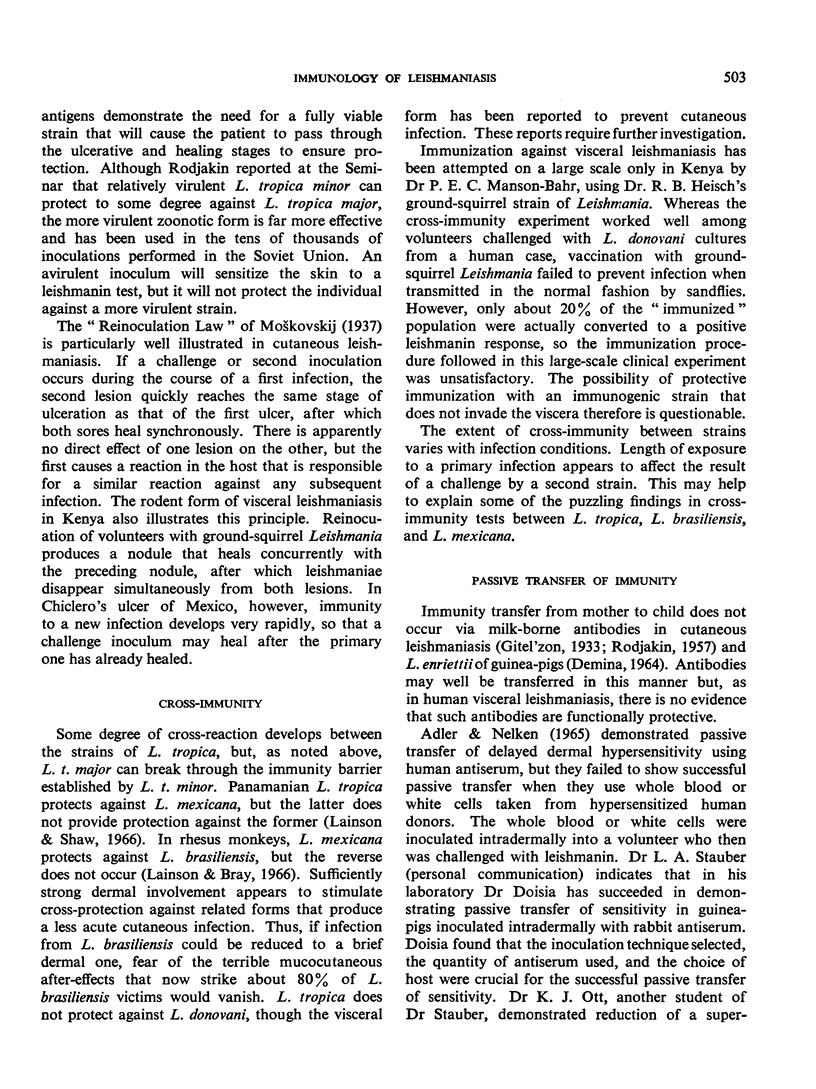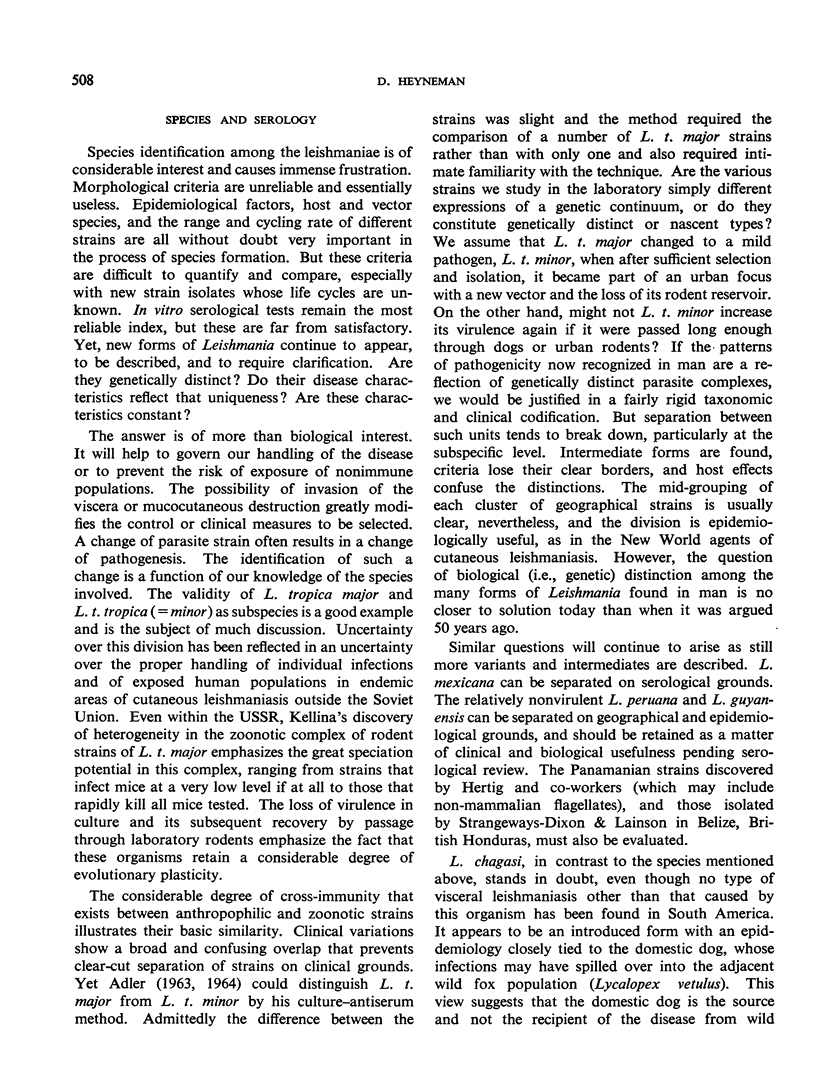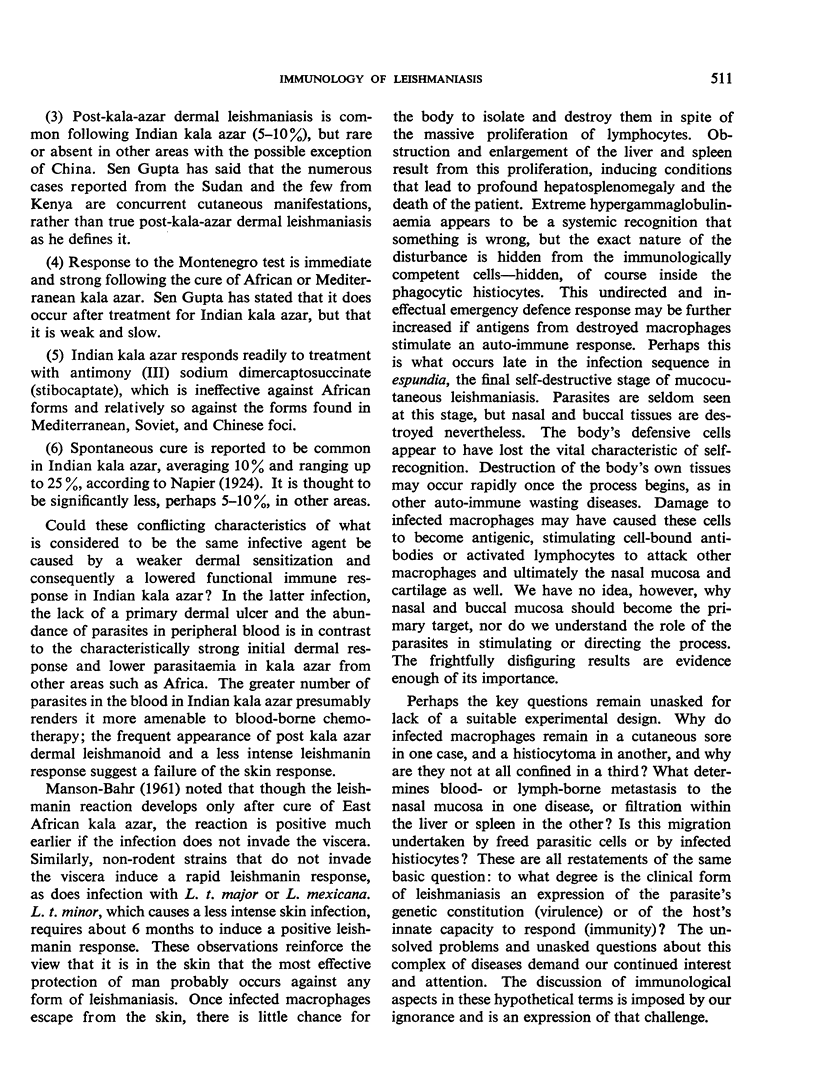Abstract
Knowledge of the immunological basis of the leishmaniases and of the host's response is fragmentary and largely pragmatic. This paper reviews certain conceptual and clinical aspects of the immunology of these diseases. Consideration is given to man's natural resistance and his ability to acquire resistance from natural infections and from vaccination. The age-distribution of infection in different populations is discussed in relation to the effects that interaction between the parasite and its intermediate host may have on its infection characteristics and virulence.
Studies in the USSR of differences in virulence among 30 human strains and 39 rodent strains are reported. The rodent strains showed a broader range of virulence than did the human isolates. Serological tests for determining species relationships among the leishmaniae are generally nonspecific, but work concerned with the development of the antiserum—culture test is reviewed. Species identification and the recognition of new forms, perhaps with different infection characteristics, is, nevertheless, of the utmost importance in the prevention and treatment of the disease.
The review concludes with a discussion of functional immunity and hypotheses of the immune process in leishmaniasis.
Full text
PDF















Selected References
These references are in PubMed. This may not be the complete list of references from this article.
- ACTOR P. Protein and vitamin intake and visceral leishmaniasis in the mouse. Exp Parasitol. 1960 Sep;10:1–20. doi: 10.1016/0014-4894(60)90078-3. [DOI] [PubMed] [Google Scholar]
- ADLER S., NELKEN D. ATTEMPTS TO TRANSFER DELAYED HYPERSENSITIVITY TO LEISHMANIA TROPICA BY LEUCOCYTES AND WHOLE BLOOD. Trans R Soc Trop Med Hyg. 1965 Jan;59:59–63. doi: 10.1016/0035-9203(65)90139-2. [DOI] [PubMed] [Google Scholar]
- ANSARI N., FAGHIH M. Leishmaniose cutanée a L. tropica chez Rhombomys opimus. Ann Parasitol Hum Comp. 1953;28(4):241–246. [PubMed] [Google Scholar]
- Adler S., Foner A., Montiglio B. The relationship between human and animal strains of Leishmania from the Sudan. Trans R Soc Trop Med Hyg. 1966;60(3):380–386. doi: 10.1016/0035-9203(66)90305-1. [DOI] [PubMed] [Google Scholar]
- Armstrong T. G. Asymptomatic Kala-azar in Soldiers from Over-seas. Br Med J. 1945 Dec 29;2(4434):918–918. [PMC free article] [PubMed] [Google Scholar]
- Bray R. S. Studies on the immunology and serology of leishmaniasis: VI. Searh for antigenic variation in single strains of Leishmania spp. Trans R Soc Trop Med Hyg. 1969;63(3):378–382. doi: 10.1016/0035-9203(69)90014-5. [DOI] [PubMed] [Google Scholar]
- CAHILL K. M. LEISHMANIASIS IN THE SUDAN REPUBLIC. XXI. INFECTION IN AMERICAN PERSONNEL. Am J Trop Med Hyg. 1964 Nov;13:794–799. doi: 10.4269/ajtmh.1964.13.794. [DOI] [PubMed] [Google Scholar]
- Lainson R., Bray R. S. Studies on the immunology and serology of leishmaniasis. II. Cross-immunity experiments among different forms of American cutaneous leishmaniasis in monkeys. Trans R Soc Trop Med Hyg. 1966;60(4):526–532. doi: 10.1016/0035-9203(66)90278-1. [DOI] [PubMed] [Google Scholar]
- Lainson R., Shaw J. J. Studies on the immunology and serology of leishmaniasis. 3. on the cross-immunity between Panamanian cutaneous leishmaniasis and Leishmania mexicana infection in man. Trans R Soc Trop Med Hyg. 1966;60(4):533–535. doi: 10.1016/0035-9203(66)90279-3. [DOI] [PubMed] [Google Scholar]
- MANSON-BAHR P. E. Immunity in kala-azar. Trans R Soc Trop Med Hyg. 1961 Nov;55:550–555. doi: 10.1016/0035-9203(61)90078-5. [DOI] [PubMed] [Google Scholar]
- NEAL R. A. CHEMOTHERAPY OF CUTANEOUS LEISHMANIASIS: LEISHMANIA TROPICA INFECTIONS IN MICE. Ann Trop Med Parasitol. 1964 Dec;58:420–430. doi: 10.1080/00034983.1964.11686264. [DOI] [PubMed] [Google Scholar]
- SEN GUPTA P. C. Pathogenicity of Leishmania donovani in man. Rev Inst Med Trop Sao Paulo. 1962 Mar-Apr;4:130–135. [PubMed] [Google Scholar]
- STRANGWAYS-DIXON J., LAINSON R. Dermal leishmaniasis in British Honduras: transmission of L. brasiliensis by Phlebotomus species. Br Med J. 1962 Feb 3;1(5274):297–299. doi: 10.1136/bmj.1.5274.297. [DOI] [PMC free article] [PubMed] [Google Scholar]
- Schneider C. R., Hertig M. Immunodiffusion reactions of Panamanian Leishmania. Exp Parasitol. 1966 Feb;18(1):25–34. doi: 10.1016/0014-4894(66)90004-x. [DOI] [PubMed] [Google Scholar]
- Southgate B. A., Manson-Bahr P. E. Studies in the epidemiology of East African leishmaniasis. 4. The significance of the positive leishmanin test. J Trop Med Hyg. 1967 Feb;70(2):29–33. [PubMed] [Google Scholar]
- Southgate B. A., Oriedo B. V. Studies in the epidemiology of East African leishmaniasis. 3. Immunity as a determinant of geographical distribution. J Trop Med Hyg. 1967 Jan;70(1):1–4. [PubMed] [Google Scholar]
- Vasina S. G., Demina N. A., Glazunova Z. I. Morfologicheskoe i tsitokhimicheskoe izuchenie limfaticheskikh uzlov i selezenki pri leishmanioze morskikh svinok (Leishmania enrietti) Med Parazitol (Mosk) 1965 Nov-Dec;34(6):708–713. [PubMed] [Google Scholar]


